August 5, 2018
by Carole Zangari -
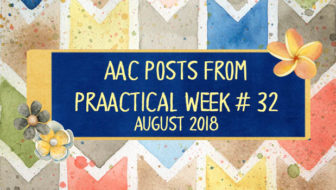
Happy Sunday, AAC friends! Here are some posts that you may have missed. Monday – 5 Ways to Support Self-Advocacy in AAC Learners Tuesday – AAC Link Up Wednesday – Video of the Week: Let’s Hit the Town, AAC Style Thursday – Making AAC Core Vocabulary Materials You might be interested in these posts if you have time for a little more reading. Back to School with AAC A Collaborative Approach to Implementing Core Vocabulary in a School-based Setting Goodbye, Summer! A Clinician Preps AAC Materials for the New School Year Essential Tricks for Supporting AAC in Schools AAC in the High School Classroom: Where Core Vocabulary Meets Life Skills
Filed under: PrAACtical Thinking
Tagged With: back to school, school, summary post
August 2, 2018
by Carole Zangari -
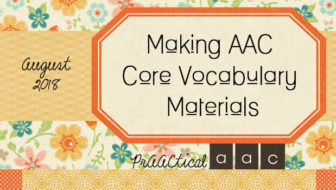
It’s Throwback Thursday and today we’re revisiting some past posts on making AAC materials that include core vocabulary. Getting Ready for a Core Vocabulary Journey Manual Communication Boards with Core Vocabulary Make It Monday: More Words, Please! Expanding Our Manual Communication Boards Super Size It: 5 Ideas for Making Large Communication Boards
Filed under: Featured Posts, PrAACtical Thinking
Tagged With: core vocabulary
July 30, 2018
by Carole Zangari -
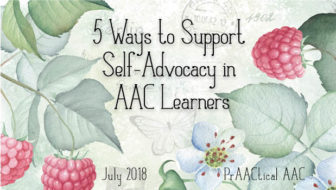
self-ad·vo·ca·cy: self ˈadvəkəsē/ Noun: the action of representing oneself or one’s views or interests. —————————- Empowering AAC learners to advocate for themselves may be one of the most important and impactful things that we can do to help them stay safe and achieve their goals. Here are some ways we can support that process. Provide messages for self-advocacy behaviors: It’s hard to represent your own interests without the appropriate set of vocabulary and messages. Words and prestored messages for protesting and rejecting are essential (e.g., No; Stop; No, thank you; I don’t want to). In addition, consider adding messages which allow the communicator to express disagreement or negative opinions (e.g., I don’t like it; I don’t think so; That doesn’t work for me; This is unfair; That’s disrespectful) and proactively provide self-advocacy information (e.g., Please do what I asked; It’s on my IEP; I have a right to be heard; I... [Read More...]
Filed under: Featured Posts, PrAACtical Thinking
Tagged With: advocacy, self-advocacy, vocabulary selection
July 24, 2018
by Carole Zangari -
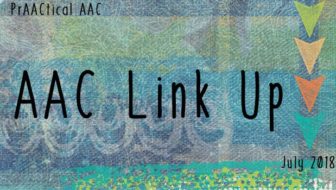
Happy Tuesday, AAC friends! Once a week, we invite you to share your own AAC-related content so that others may learn from you and benefit from your efforts. Schedules are often a little more relaxed in the summer, so share away! It may be a recent post you’ve written, a slide deck from your AAC presentation, a handout, video, or meme that you’ve posted online, an AAC product you’ve created, an announcement for an AAC camp or conference, or any other prAACtical content you developed and want to share with the AAC community. To post your own link, scroll all the way down to the bottom of this post and complete the form. Enter the URL and the name/title in the boxes provided below. The AAC Link Up is moderated to keep us from being spammed, so it may take a little while for your link to show up. Note: If you... [Read More...]
Filed under: Featured Posts, PrAACtical Thinking
Tagged With: AAC Link Up
July 23, 2018
by Carole Zangari -
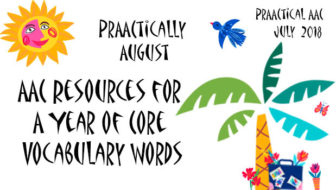
The summer is zooming by here in Florida and lots of professionals and families are starting to think about heading back to school. Teachers, therapists, and aides play a pivotal role in helping AAC learners develop skills with core vocabulary so that they have a body of words that can be used across activities, environments, and communication partners. There are lots of ‘right’ ways to support these students. Among them is an instructional approach in which a new set of core words is introduced every few weeks in order to build their experiences with AAC. Our Year of Core Words materials has two versions, Set 1 (12 words/month) and Set 2 (16 words/month; Different than the previous year’s core words). If you’ve been following along, or are just getting started, these resources may be of interest. Set 1 Words: any, bring, day, fall, give, hot, job, know, other, sick, sorry, together Set 2 Words: aide,... [Read More...]
Filed under: Featured Posts, PrAACtical Thinking
Tagged With: A Year of Core Words, Another Year of Core Words
July 19, 2018
by Carole Zangari -
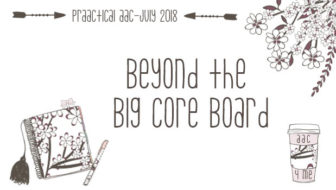
Poster-sized communication boards with core vocabulary have become popular additions to many classrooms and therapy rooms. Having these AAC options so readily accessible made it easier for some therapists, educators, paraprofessionals, and families who were relatively new to AAC, begin to embed it in conversations, lessons, and naturally-occurring routines throughout the day. And that’s a good thing! But…it’s just the beginning. Effective AAC service providers know that there are many more steps on the path to communicative competence. Let’s keep going! One important thing to do at this stage is to customize the AAC display to meet the specific needs and abilities of our individual students. One size doesn’t fit all. If you’re ready to move forward in your own AAC support practices, here are a few questions you can ask yourself to identify some potential next steps. How can I ensure that my beginning communicators have access to words... [Read More...]
Filed under: Featured Posts, PrAACtical Thinking
Tagged With: core vocabulary, precision AAC
July 16, 2018
by Carole Zangari -
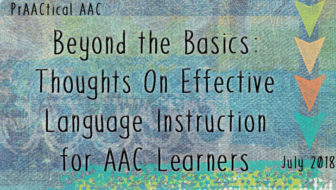
Have you worked with students like these? Gaby has been using SGDs since kindergarten. As she approaches high school, Gaby is able to express many things but her language is significantly below those of her peers. This makes it difficult for Gaby to read grade-level textbooks with comprehension, complete writing assignments, and perform well on academic tests. Ian’s SLP and teacher are trying to understand why he is able to learn new language skills but seems to lose some of them when they start working on new goal areas. When the time came for a speech-language re-evaluation, they were surprised that Ian scored so poorly in areas where he made mastered his IEP goals. Brandon is a fifth grader who wants to go to college someday. His language skills have been growing steadily since he got his first AAC device several years ago, but are still remarkably delayed. In situations... [Read More...]
Filed under: Featured Posts, PrAACtical Thinking
Tagged With: language therapy
July 12, 2018
by Carole Zangari -
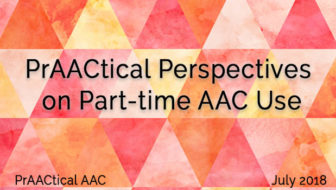
Can AAC be of benefit to people who speak? Today, we welcome Alyssa Hillary Zisk, an Autistic PhD student in the Interdisciplinary Neuroscience Program at the University of Rhode Island, who shares their experiences with part-time AAC use. :::::::::::::::::::::::::::::::::::::::::::::::::::::::::::: Think about a person who uses AAC. I’m probably not the person you thought of. For one thing, I’m an autistic adult, and the AAC research I’ve seen relating to autism is generally about kids. Services are generally aimed at kids too. For another, my AAC use isn’t the result of having consulted with a specialist who evaluated me and suggested possible strategies. Oh, and my speech sounds pretty fluent, in two languages — when I can talk. That’s not always, and there is the reason I use AAC. I’ve always had somewhat intermittent speech – that is, I can talk, but only sometimes. For this reason, I use a variety of... [Read More...]
Filed under: Featured Posts, PrAACtical Thinking
July 9, 2018
by Carole Zangari -
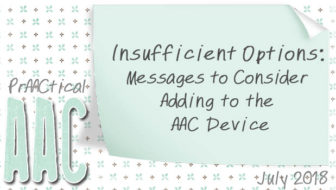
How would it feel to be really hungry but allergic to everything on the menu at the only place in town that is still serving food? Can you imagine finding comfortable shoes that you were dying to buy to wear with your navy suit except that they only had fuschia and neon yellow in your size? Have you ever been frustrated by filling out a form that gave only choices for racial groups that you don’t identify with? Let’s face it: It’s incredibly, maddeningly, and impossibly frustrating when our options are overly limited or the choices don’t include things that we want or need. We feel trapped. It’s frustrating, demeaning, and downright infuriating to be constrained in those ways. And yet, most people who use AAC face that situation every day. Their language is limited by the options available to them in their SGDs, communication books, or AAC apps. Until... [Read More...]
Filed under: Featured Posts, PrAACtical Thinking
Tagged With: communication breakdown, message selection, repair strategies
July 5, 2018
by Carole Zangari -
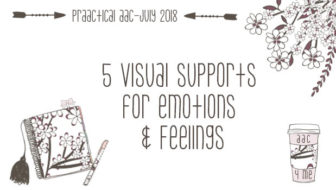
“I wish he could tell me what he is feeling.” Families and professionals often share the desire to help AAC learners become more proficient at expressing their emotions. Goals for identifying and/or labeling emotions are common in beginning AAC users, but even communicators with more advanced language skills can benefit from expanding their vocabulary of terms related to feelings. In this post, we share visual supports that can be helpful in increasing the emotional vocabularies of individuals with AAC needs. Click on the title to get downloadable copies of each visual support. Inside Out Chart Emotion Wheel Plutchik Wheel Emotions Wheel Worksheet from Childhood 101 Primary and Secondary Emotion Wheel
Filed under: Featured Posts, PrAACtical Thinking
Tagged With: emotions, feelings, visual supports









